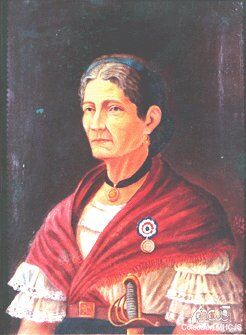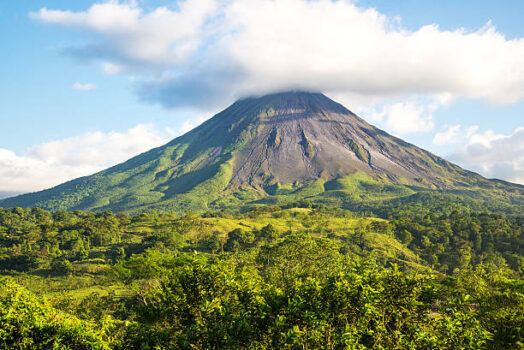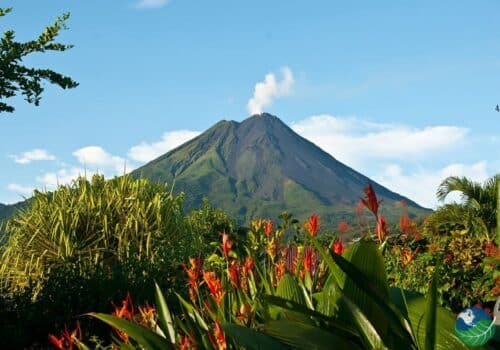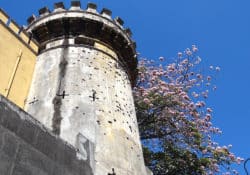Costa Rica has always been a country of relative peace and prosperity compared to its neighbors. While the 19th century is marked by economic growth, the country also underwent notable political changes. Although Costa Rica was a bystander of some historical events rather than a participator, there are several instances where they took action, each of them with a quite significant outcome.
The arrival of the 20th century brought with it more blood but also more change. After a brief period under military dictator and the bloodiest civil war in Costa Rican history, the country made a radical choice that still defines its identity to this day.

The independence from Spain and the first and second civil war
The first noteworthy victory the Costa Ricans shared with the rest of Central America, was a bloodless one on their part. The Napoleonic invasion of Spain in 1808 weakened Spanish authority in Latin America. Inspired by the age of enlightenment and the American and French revolutions, voices started to rise and the call for independence had irrevocably freed the way for rebels and heroes.
Back then, Costa Rica was part of the territory of New Spain which reached all the way up to Mexico. And it was Mexico who took up arms against Spain in an 11 year battle to freedom stretching from the Cry of Dolores in 1810, to the Army of Three Guarantees. Central America gained its independence by proxy as the Mexican War of Independence reached its climax in 1821 and freed the subcontinent, later creating the first Mexican Empire.

Padre Miguel Hidalgo cries for freedom from Spain in the town of Dolores. Fresco by José Clemente Orozco, 1937–38, Palacio de Gobierno.
Point of no return – Costa Rica’s full independence
While the idea of a Mexican Empire sat well with the conservative movements in the colonial capital of Cartago, others wanted to take it further. On April 5th 1823, the Republicans of San Jose and Alajuela rose up against the Imperialist Cartago in the Battle of Ochomogo, so named because it took place on the Ochomogo Hill west of Cartago. After a brief attempt to negotiate, passions rose and both sides opened fire, taking cover in the volcanic rock formations that surrounded the area. After a battle that killed roundabout 20 people, the republicans were victorious and constituted San Jose as the new capital of the country.
Several weeks after the civil war, however, the people of Costa Rica learned that the Mexican Empire had ceased to exist as of March 19th, 1823, and the battle had in fact been pointless. Costa Rica was now a member state of the Federal Republic of Central America.
That being said, the Ochomogo War had revealed the opposing values dividing the Central Valley. The rivalry between the towns of Alajuela and San Jose and Cartago and Heredia continued as they rotated power between the four of them for the coming 12 years.
A free Costa Rica
Wanting to break free from the so called “Ambulance Law” which allowed for the rotation of the capital between the 4 cities, the idealistic values that first divided the valley were lifted and each city wanted to fight for its own right to become the permanent capital of the free state of Costa Rica. This culminated in the second civil war known as League War (1835). The war firmly declared for San Jose after two battles known as the Battle of Cuesta de Moras and the Battle of the Virilla River meant defeat for Heredia, Alajuela and Cartago.
In 1838, long after the Federal Republic had already ceased to function in practice, Costa Rica withdrew itself from the republic and officially declared its full sovereignty.
Holding on to independence: The Filibuster War
Costa Rica’s independence was challenged a mere 18 years later when filibuster William Walker pursued his ambition to establish colonies within Latin America. After usurping the Nicaraguan government in 1856, he sent mercenary troops to what is now Santa Rosa National Park, Guanacaste. A makeshift army of Costa Rican civilians completely overwhelmed the mercenaries and the battle lasted all of 14 minutes. They pushed Walker’s forces back into Nicaragua and less than a month later, the deciding Battle of Rivas claimed victory for the Costa Ricans and created two national heroes still remembered to this day.
Francisca ‘Pancha’ Carrasco: the heroine who challenged gender roles
 Pancha Carrasco was born in Cartago on April 8th of 1816. By the time filibuster William Walker sent his mercenaries to Costa Rica, Carrasco was 40 years old. Some accounts state that Carrasco was always set on bending the “rules of the sexes” by learning to read and ride horses. When William Walker overthrew the Nicaraguan government in 1856 and threatened the independence of other Central American nations, president Juan Rafael Mora Porras called upon the Costa Rican people to take up arms and push back the filibuster’s troops.
Pancha Carrasco was born in Cartago on April 8th of 1816. By the time filibuster William Walker sent his mercenaries to Costa Rica, Carrasco was 40 years old. Some accounts state that Carrasco was always set on bending the “rules of the sexes” by learning to read and ride horses. When William Walker overthrew the Nicaraguan government in 1856 and threatened the independence of other Central American nations, president Juan Rafael Mora Porras called upon the Costa Rican people to take up arms and push back the filibuster’s troops.
Carrasco joined the army as a cook and a medic but famously wanted her contribution to carry more weight. With an apron full of bullets, she grabbed a rifle and joined the army’s defenses during the Second Battle of Rivas, effectively becoming the first woman in Costa Rica’s military. Her now legendary bravery has rewarded her with a Costa Rican postage stamp, a coast guard vessel carrying her name and the creation of the “Pancha Carrasco Police Women’s Excellence Award”.
Juan Santamaria: from drummer boy to national hero
While few will actually come across any reference to Pancha Carrasco during their travels to Costa Rica, anyone arriving in San Jose by plane will visit the airport named after Juan Santamaria, a drummer boy whose passion and bravery helped end the Second Battle of Rivas.
Juan Santamaria was born in Alajuela in 1831 and was a poor laborer living alone with his mother. He joined the army as a drummer boy and marched to Rivas in pursuit of Walker’s forcers. His spiky hair affectionately earned him the nickname of el erizo (the sea urchin).
While Walker’s soldiers took refuge in a wooden fort, general José María Cañas called for volunteers to burn it down. The traditional account states that after several soldiers failed, it was Santamaria who then offered to try on condition that someone would look after his mother if the worst should happen. Although mortally wounded in the process, he succeeded and his actions helped bring the Costa Ricans to victory. Other than naming the main international airport in his birth town after him, Juan Santamaria also has a museum dedicated to him as well as a statue. Every year on April 11th, the Costa Ricans commemorate his death by celebrating Juan Santamaria Day.

The hero of peace
The 20th century is a time of extremes for Costa Rica. While they formally declared war against Germany in 1918, this declaration never moved beyond words on a paper. Instead, the years of 1917 to 1919 were marked by a brief military dictatorship under general Federico Tinoco Granados. After Tinico was overthrow and forced into exile, the military he had used to control the populace rapidly declined in influence as well as size.
While Costa Rica did contribute forces to the allies in World War II, the country went through more significant transformations after the war. A dispute rose in the presidential election between Rafael Ángel Calderón Guardia and Otilio Ulate Blanco. This dispute brought another national hero to the stage who would be the catalyst for Costa Rica’s most radical change yet.
1948: the abolition of the army
In 1948, José Figueres Ferrer led an army in wake of the dispute and launched with it the bloodiest civil war in Costa Rican history, resulting in more than 2000 dead over a course of 44 days. While the majority of Europe was still licking its wounds, the rebels prevailed and constituted a junta that abolished the military in Costa Rica. Additionally, they oversaw the governmental reform as democratic articles were drawn up and a new constitution set in place. After the reforms were enacted the following year, the Junta’s power was transferred.
José Figueres Ferrer became a national hero and won the country’s first democratic election in 1953. A small uprising was organized by supporters of former president Calderon in 1955, but to little avail.
Other than abolishing the army, Figueres is remembered for nationalizing the banking sector, granting Afro-decedents and women the right to vote, and formally granting the people of African descent with a Costa Rican nationality.
|
|
|
Figueres’ influence led to a positive evolution for human rights and to this date, Costa Rica has enjoyed a stable democracy that has had 14 presidential elections so far. The 2018 election was won by Carlos Alvarado Quesada of the progressive Citizen’s Action Party. Under Quesada, issues such as same-sex marriage and climate change were brought to the table, bringing an already peaceful Costa Rica closer to the ideals of the modern age.
AUTHOR’S BIO
 Hi! My name is Mieke and I am one of the My Costa Rica writers/editors! I am originally from Belgium but after traveling for about a year, I decided to settle here in Costa Rica and carve out a life for myself. I have visited many countries including Nepal, Nicaragua, Bolivia, Peru, Mexico, and of course Costa Rica. Before I left for this wonderful adventure, I was a hotel Shift-Leader in Gent, Belgium. In fact, I have had a lot of different jobs from organizing events to cleaning offices but I feel with writing and editing I have discovered my true calling. Back in 2012 I received my master’s degree in Art History. Studying art has made me appreciate cultural diversity and expression which I have been able to build on greatly during my travels and now for my job!
Hi! My name is Mieke and I am one of the My Costa Rica writers/editors! I am originally from Belgium but after traveling for about a year, I decided to settle here in Costa Rica and carve out a life for myself. I have visited many countries including Nepal, Nicaragua, Bolivia, Peru, Mexico, and of course Costa Rica. Before I left for this wonderful adventure, I was a hotel Shift-Leader in Gent, Belgium. In fact, I have had a lot of different jobs from organizing events to cleaning offices but I feel with writing and editing I have discovered my true calling. Back in 2012 I received my master’s degree in Art History. Studying art has made me appreciate cultural diversity and expression which I have been able to build on greatly during my travels and now for my job!
Read our Privacy Policy - Sitemap.


















Follow Us